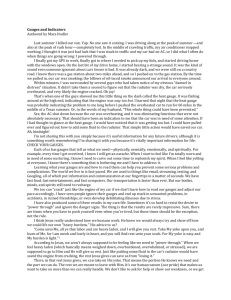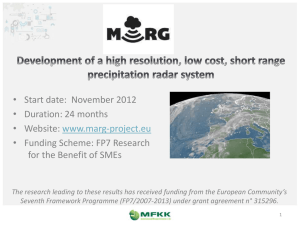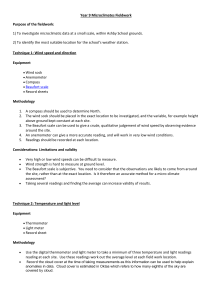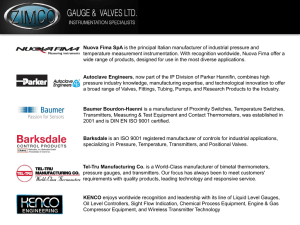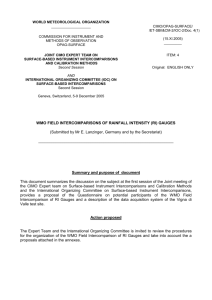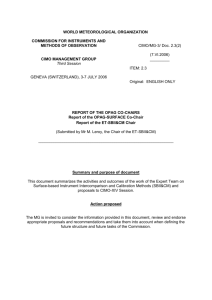5-7_RI_Intercomparison_Summary_v2_20140515
advertisement
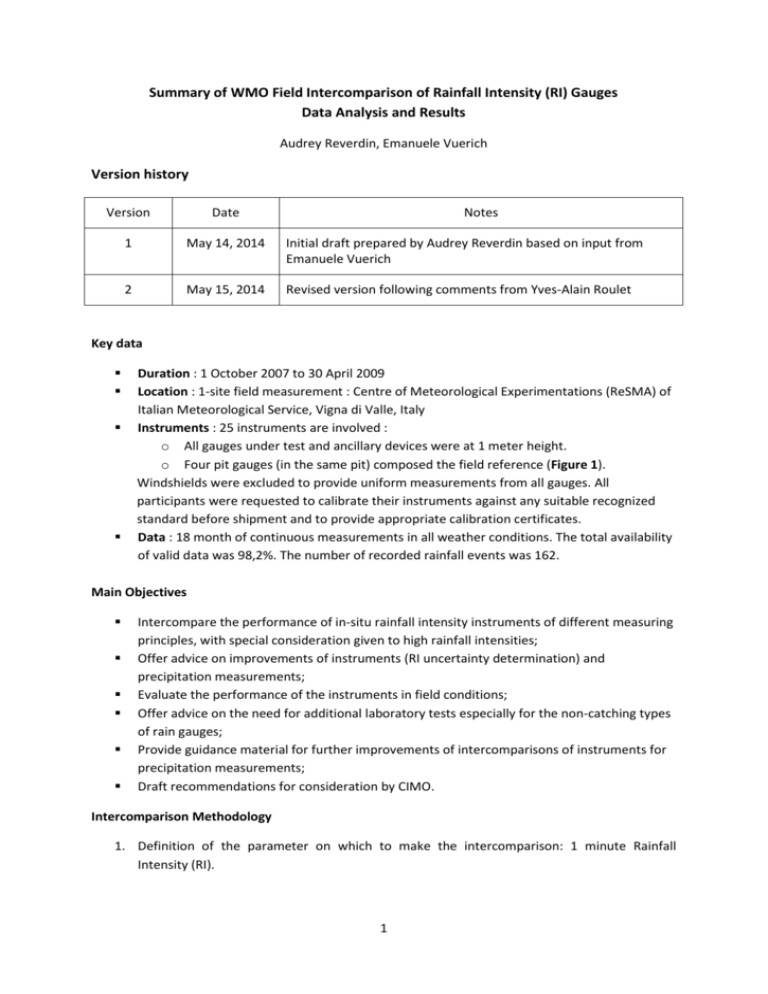
Summary of WMO Field Intercomparison of Rainfall Intensity (RI) Gauges Data Analysis and Results Audrey Reverdin, Emanuele Vuerich Version history Version Date Notes 1 May 14, 2014 Initial draft prepared by Audrey Reverdin based on input from Emanuele Vuerich 2 May 15, 2014 Revised version following comments from Yves-Alain Roulet Key data Duration : 1 October 2007 to 30 April 2009 Location : 1-site field measurement : Centre of Meteorological Experimentations (ReSMA) of Italian Meteorological Service, Vigna di Valle, Italy Instruments : 25 instruments are involved : o All gauges under test and ancillary devices were at 1 meter height. o Four pit gauges (in the same pit) composed the field reference (Figure 1). Windshields were excluded to provide uniform measurements from all gauges. All participants were requested to calibrate their instruments against any suitable recognized standard before shipment and to provide appropriate calibration certificates. Data : 18 month of continuous measurements in all weather conditions. The total availability of valid data was 98,2%. The number of recorded rainfall events was 162. Main Objectives Intercompare the performance of in-situ rainfall intensity instruments of different measuring principles, with special consideration given to high rainfall intensities; Offer advice on improvements of instruments (RI uncertainty determination) and precipitation measurements; Evaluate the performance of the instruments in field conditions; Offer advice on the need for additional laboratory tests especially for the non-catching types of rain gauges; Provide guidance material for further improvements of intercomparisons of instruments for precipitation measurements; Draft recommendations for consideration by CIMO. Intercomparison Methodology 1. Definition of the parameter on which to make the intercomparison: 1 minute Rainfall Intensity (RI). 1 2. Definition of the time interval or temporal resolution for the evaluation of this parameter: primary 1 min and secondary 5 min, leading to a dimension of the general database of approximately 750 data of 1 min RI (statistical significance of the site database). 3. Application of the QA/QC routines on reference data as well as on other gauges data. This leads to a reduction of the database containing only valid data for the defined temporal resolution and enables to calculate and report the percentage of valid data compared to the unchecked data. 4. Definition in a robustly-scientific way how to retrieve the Field Reference for that parameter: with 4 reference gauges on site, a composite field reference has been determined following a very specific construction approach (WMO Field Intercomparison on RI gauges Report, p.45). 5. Verification that all gauges data are synchronized with the timestamp of the data acquisition system. The satisfaction of this requirement is directly proportional to the capability of the site managers in properly and correctly integrating the intercomparison gauges into the DA system or logger. 6. Determination of the measurement expanded uncertainty in field conditions of the composite reference. This parameter is directly proportional to the accuracy of the estimation of the true precipitation value in field conditions and is very important to derive the accordance of all participating gauges to the reference. A “tolerance region” has been defined in adding to this uncertainty the so called WMO limits of +/-5%. The combination of those two uncertainties leads to an interval to be reported on plots. 7. Evaluation of the precipitation QC-checked data of each gauges versus QC-checked reference data at the time resolutions selected at point 2: generally a linear or power law theoretical curve has been adopted to find the correlation between the two and a correlation coefficient enabled to assess the accuracy of the correlation. Instruments involved Figure 1 – The 4 working reference RI gauges in the RRGP (Reference Rain Gauge Pit) 2 Table 1 – The list of participating instruments. Instruments in bold are the 4 references of the RI Intercomparison. Instruments highlighted in red are operated in SPICE (as reference or under test) . Site Layout Figure 2 – WMO Field Intercomparison : Instruments Positionning 3 Data Analysis and Main Results Main objective of data analysis: Provide guidance on improving the homogeneity of long-term records of rainfall with special consideration given to high rainfall intensity. Automatic QC : Raw data were processed in near-real time by the Automatic Quality Control (AQC) implemented on a separated CPU in order to provide quality checked 1min RI data, quality checked 1min ancillary data and QC information (e.g. flags, suspect data, erroneous data, etc.) to be used for data analysis and evaluation of results. Events selection : The events used for the RI data analysis had to be characterize by rainfall data with at least 2 consecutive minutes with RI1min>12mm/h. A total of 43 events were used for the data analysis of all rain gauges. Precipitation type : Only liquid precipitation events were evaluated. The identification of precipitation type was based on the SYNOP, METAR, and SPECI messages created by ReSMA H24 weather station. Methodology : The analysis of the 1-minute RI data was done through different steps : 1) A reliable 1-min working RI reference made up from the four reference rain gauges was determined : The method consisted of a statistical evaluation of the experimental data using a weighted average. It is obtained from the rainfall intensities measured by the 4 references. Calculation of weights was the most challenging issue; a purely statistical evaluation was not sufficient, it was necessary to take into account effects related both to dynamic internal characteristics and the possible lack of synchronization on 1minute time base. Eleven 1-min RI events were selected to develop the best method for the calculation of the 1-min RI composite working reference. In order to analyze the behavior of the four reference gauges in those considered rainfall events, the relative difference (RD) between the measured rainfall intensities and the RI composite working references on 1 minute time scale were computed (Figure 3). As a result, R102-ETG and T200B-GEONOR were the two gauges representing the most reliable set of references through the evaluated events. Uncertainty of the reference has been determined using a specific approach and led to the value of 4.3 mm/h. In order to compare the gauges to the reference and to assess their agreement with the user uncertainty requirement, a tolerance region was established. This tolerance region was composed of the uncertainty of the reference and the 5% of WMO required measurement uncertainty according to the CIMO Guide (WMO, 2008a, Part I, Chap.1, Annex 1.B). This tolerance region is reported as upper and lower lines in following plots. 4 Figure 3 – Results of relative difference (RD) between measured RI and RI composite working reference for the 4 reference gauges. 2) Each rain gauge data were analysed in comparison with the calculated 1-min RI reference, and its performance and possible relation with weather conditions were evaluated. Plots representing the trend of each instrument compared to RI composite working reference were performed, with the correlation coefficient indicated for each trend. The following remarks could be done : Catching type rain gauges (Figure 4a,b) : The achievable accuracy of WG can be improved in field conditions by means of the reduction of the response time below 1-minute and by appropriate filtering methods. Non-catching type rain gauges (Figure 4c) : During the intercomparison period, the non-catching type rain gauges needed low maintenance and few periodic checks, thus this kind of instruments is considered particularly suitable for automatic weather stations or generally unmanned meteorological stations. LPM-THIES and PARSIVEL-OTT optical disdrometers show a low spread of data and a linear behavior in the full range of plots with an overestimation trend. PWD22-VAISALA has a non-linear behavior and tends to underestimate RI, with large dispersion of data. His R2 correlation coefficient is very low, so the fit is not representative of this sensor. The field intercomparison has shown the need to improve calibration methods adopted for non-catching rain gauges for 1-minute RI measurements. None of the non-catching rain gauges agreed well with the reference. Despite very different calibration procedures among disdrometers, they agreed better to each other than to the reference. This indicates that they had a good degree of precision but were not as accurate as conventional gauges. 5 (a) (b) (c) Figure 4 : a) and b) Catching and c) Non-Catching precipitation sensors compared to RI composite working reference 6 3) The wind effect study on the 1-minute RI measurements was performed through the comparison of identical instruments that are placed inside and outside the pit. Figure 5 shows ratio between both (outside/inside pit) as a function of wind speed for the 1minute data from T200B-GEONOR and R102-ETG gauges : Data were measured at very low wind speeds, generally lower than 4m/s. Linear trend is shown to point out the general behavior of the ratio RIout/RIpit with increasing wind. Figure 6a illustrates all the rainfall intensity data from T200B- GEONOR gauge measured in the period from October 2007 to April 2009, where RIout/RIpit is reported for increasing values of RIpit. This plot aim to point out possible differences in the ratio RIout/RIpit due to the wind when the rainfall intensity increases. Figure 6b is similar but with 1-minute RI data averaged according to “classes” of RI values. The effect cannot be evaluated for low wind speed conditions because of the presence of the 1-min data dispersion (mainly due to the difference of calibration between the two identical gauges). Only few rainfall events happened with moderate or strong wind (above 5m/s). Their number do not permit a complete evaluation of wind induced losses. The reference pit gauges generally measured higher rainfall intensities than their identical gauges installed outside, but a correlation/relationship between wind speed and 1-min RI reduction cannot be determined. Thus, the effect due to wind losses cannot be quantitatively estimated. Conclusion : For low wind speed, the Jevons effect weakly affected the field intercomparison RI measurement and, for moderate-strong winds (>5m/s), it was more intense but without a feasible quantitative determination. Figure 5 : Ratio between 1-min RI measured by the pit and RI measured by the identical gauge outside the pit. 7 Figure 6 : 1-min T200B-GEONOR RI; RIout/RIpit vs RIpit is shown, divided in groups (a) of wind speed conditions, (b) according to the wind speed conditions, then divided in groups of intensity and averaged inside each group. 8 Other Interesting Results for the SPICE project The intercomparison results confirmed that uncorrected tipping bucket rain gauges measurement should be corrected. Catching gauges that do not have a funnel are sensitive to environmental factors. It was found that proper techniques can be used to reduce the noise in the measurements. It was found that manufacturers need to improve their documentation, and users should contact manufacturers for additional guidance, as how to best operate their instruments for various applications. The laboratory phase of the RI Field Intercomparison proved to be essential in providing basic information on the behavior of the catching type instruments. Recommendations that may be of interest for SPICE The user should carefully check the manufacturer’s documentation about the characteristics of parameters and ask for additional information, if necessary, as it appeared during the intercomparison that it is not always obvious to identify the parameters that should be used (Recommendation 2). Although this intercomparison has its emphasis on high RI, it became obvious that most instruments needed to be improved in the lower RI range. It is recommended to manufacturers to improve the design of their instruments to reduce the uncertainty of 1-min RI measurement at intensities below 20mm/h (Recommentation 8). It is recommended that (Recommendation 10) : o the procedure adopted for performing calibration tests in the laboratory should become a standard method to be used for assessing the instruments’ performance. o Classification of instrument performance be developed. This could be based on the results of laboratory tests and on user application requirements. The different classes of instruments would help users in selecting the proper instrument for their applications. As a guideline for future Intercomparison initiatives involving instruments that cannot be directly compared to a primary, secondary or reference standard, it is recommended that a “composite working reference” is derived using more than one instrument to provide the best estimate. This concept is based on the experience of the present Intercomparison of RI gauges, by selecting a number of instruments with the best observed/expected performance under independent assessment (e.g. from laboratory tests, or other available information) and to derive a “composite” measure from the combination of their respective measures using suitable statistic and/or conceptual tools (Recommendation 12). Throughout the intercomparison, the International Organizing Committee (IOC) held regular teleconferences to monitor the progress of the intercomparison, to provide advice to the local host and to develop the final report. This proved to be extremely effective. It is therefore recommended that the IOC of future intercomparisons considerd having regular teleconferences (Recommendation 13) It is recommended that the developed expertise and the infrastructure at the Intercomparison sites (both the field and the laboratory components) and any related 9 available facilities be further exploited within WMO beyond the time limits of this intercomparison (Recommendation 15). The Intercomparison data set (1-min rainfall intensity data) constitutes an important resource that should be considered as a valuable product for further use with various possible objectives (Recommendation 17). 10

